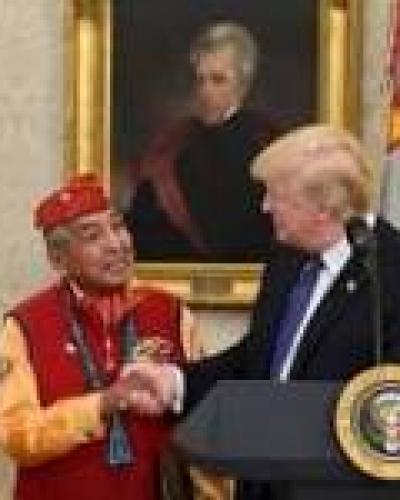Washington, November 29 (RHC)-- The prominent placement of an Andrew Jackson portrait during an event meant to honor a group of Native Americans at the Oval Office has raised questions about the White House’s message. A former president, Jackson was known for his harsh treatment of Native Americans, infamously signing the Indian Removal Act, which led to thousands of Native American deaths as tens of thousands were forced to relocate. Some observers thought the juxtaposition of his portrait during the event with the stated purpose of honoring three Navajo code talkers was strange.
“We noticed,” said Jacqueline Pata, executive director of the National Congress of American Indians. “Andrew Jackson wasn’t necessarily a president who was respectful of tribal governments and Native Americans. This is one of those eras that is probably bleaker in terms of the relationship between Native Americans and the federal government.” The portrait was visible for the entirety of the White House’s 17-minute broadcast of the event.
As president from 1829 to 1837, Jackson is perhaps most famous for his pivotal role in Native Americans’ painful and violent history in the United States. He signed the Indian Removal Act in 1830, which forced the relocation of more than 60,000 Native Americans to clear the way for white settlers. The act helped lead to the “Trail of Tears,” in which an estimated 4,000 Cherokee died during the harsh conditions of a long march during a forced relocation in 1838 and 1839. The Cherokees called Jackson “Indian killer”; the Creek called him “Sharp Knife.”
A slave owner, Andrew Jackson spoke about Native Americans as if they were an inferior group of people. “Established in the midst of a superior race,” he said of the Cherokee, “they must disappear.” He argued that removing Native Americans from their land would “enable them to pursue happiness in their own way, and under their own rude institutions.”
Trump’s affinity for Jackson has long been a facet of his public image as a politician. He lambasted an Obama administration plan, which has not yet taken effect, to remove Jackson from the $20 bill in favor of abolitionist Harriet Tubman, referring to Jackson during the presidential campaign as someone with “a history of tremendous success for the country.” And just days after his inauguration in January, Trump selected a portrait of Jackson in the Oval Office. In March, he stopped by the Hermitage, Jackson’s home in Tennessee, to lay a wreath at the former president’s tomb. The president’s former chief strategist, Stephen K. Bannon, lauded Trump’s inauguration address as “Jacksonian.”
Gyasi Ross, an author from Washington state and member of the Blackfeet Nation tribe, said he considered the portrait’s prominence during the news conference to be an intentional slight. “It’s an incredibly distasteful wink in front of people who have sacrificed so much,” he said. “Donald Trump is not a stupid man. He understands visuals and optics: His background is in television. So all of that stuff, I believe, is very deliberate.”
U.S. President Donald Trump Insults Native Americans at White House Event

Matérias relacionadas
Comentários
Deixe um comentário
Todos os campos são requeridosMais vistas
- Ministros das Relações Exteriores ajustam documentos para aprovação pelos presidentes na Cúpula da CELAC
- A pedra no sapato
- Claver-Carone, o prazer de causar dor em curto prazo
- Honduras destaca vigência da unidade da América Latina e o Caribe
- Nicolás Maduro recorda golpe militar contra Hugo Chávez em 2002

